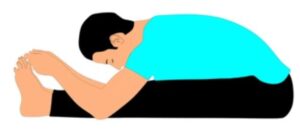Introduction to Paschimottasana

The meaning of this Sanskrit word means the intense stretch of the pack portion of the body (Patel, HOD, Palnitkar, & Upalanchiwar, 2018). In this yoga, the practitioners seat in a seated posture and fold the upper body, so that the hamstrings and the muscles can be stretched. Another name of this yoga is seated forward bend.
Physical and health benefits of Paschimottanasana
The entire body becomes stretched after doing this yoga, especially the muscles in the spinal cord region and back, thus helping to improve the blood circulation of the body. While practicing yoga, the calf muscles become stretched and help in shaping the legs (Patel, HOD, Palnitkar, & Upalanchiwar, 2018). The muscles around the neck and shoulders are also become strengthened. Regular practicing of yoga helps in toning the muscles of the back, hamstrings, legs, thus helping in shedding off extra fat from the body.

Moreover, while practicing this yoga, the body moves forward, thus putting pressure on the digestive organs, making the digestive system more effective (Patel, HOD, Palnitkar, & Upalanchiwar, 2018). Yoga also puts pressure on the thorax and the abdomen thus helping in enhancing the efficiency of the respiratory system. Besides all these benefits, regular practicing of this yoga also helps in curing diabetic patients and liver and kidney injuries.
Safety and precautions
The yoga instructors strictly instruct pregnant women to avoid this yoga, as it involves the bending of the abdomen. They suggest that the bending must start from the groin area, as bending back can sometimes harm the practitioners. While doing the yoga, the sternum should be uplifted and the practitioner should keep the spine straight and should remember that the bending should start down from their back (Lestari, Wati, Juanamasta, Thrisnadewi, & Sintya, 2019). For beginners, the instructors suggest the practitioners keep a pillow beneath their hip, this will help them to take the burden off from them to some extent and help the beginners to perform the yoga efficiently (Patel, HOD, Palnitkar, & Upalanchiwar, 2018). While practicing yoga, the practitioners should always pay attention to keeping their torso straight. The yoga instructors suggest that individuals suffering from any kind of groin injury and having cardiac problems should avoid trying this yoga, as it can cause severe injuries. Beginners can hold this pose for 30 seconds to 1 minute and after gaining strength, the practitioners can hold the pose for 4 to 5 minutes.
References
Lestari, T. R., Wati, N. M., Juanamasta, I. G., Thrisnadewi, N. L., & Sintya, N. K. (2019). Pengaruh Terapi Yoga (Paschimottanasana Dan Adho Mukha Padmasana) Terhadap Intensitas Nyeri Pada Remaja Putri Yang Mengalami Dismenore Primer. Journal of Health Science and Prevention, 9(2), 94-100. Retrieved from http://jurnalfpk.uinsby.ac.id/index.php/jhsp/article/download/221/163
Patel, S., HOD, M. D., Palnitkar, M., & Upalanchiwar, S. (2018). RELEVANCE OF YOGA THROUGH PASCHIMOTTANASANA ON TYPE 2 DIABETES MELLITUS-A LITERATURE REVIEW. Retrieved from https://wjpr.s3.ap-south-1.amazonaws.com/article_issue/1521182486.pdf